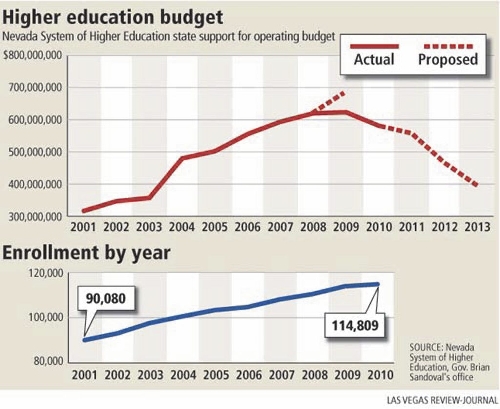Higher education to suffer, no matter which way it’s cut
Did you hear the one about the state's higher education system suffering a 42 percent budget cut?
It's true.
It's also true that the cut will be less than 3 percent.
Same cut.
Different political agendas.
And no one is lying.
Come inside the world of state budget math. It's OK. It's not that scary if you hold hands.
The state's budget is in huge trouble. When the economy tanked a few years ago, it meant tax revenue also tanked. The state government is a few billion dollars short of where it would need to be to keep spending like it has been spending.
So, cuts. There have been cuts every year for the past four years despite a massive tax increase and a big pile of money from the federal government's stimulus package last year that helped ease things a bit. There will be more cuts this year.
But there will be no tax increases if Gov. Brian Sandoval has his way. He says they're bad for business. There will be no federal help, either.
So, when the governor proposed his budget a few weeks ago, he cut the budgets of nearly every agency that gets money from the state's general fund. That is the pile of money that pays for everything from education to mental health care for the indigent.
Sandoval said his cut to higher education, which takes up more than 15 percent of all the state's general fund, was less than 7 percent.
Higher education folks -- faculty and students, bureaucrats and number crunchers -- said it was much higher than that.
Again, different political agendas.
Sandoval did his math something like this. He didn't count the $185 million in stimulus money the higher education system got. He assumed his plan that the state take $121 million in county property tax revenue and give it to the higher education system would be approved.
So what is a $400 million cut out of a $1.6 billion budget over two years ends up looking like a $90 million cut out of a $1.4 billion budget. Give or take.
And voila. "Less than 7 percent."
The folks at the Nevada Policy Research institute went even further. Using their logic -- again, totally true -- you can figure the cut down to such a measly percentage that it sounds like a mere inconvenience.
The conservative-libertarian group, which often rails against all kinds of government spending, says you should use the higher education system's entire budget when figuring the cuts, not just the state-supported part.
You see, universities get money from lots of different places. There is the state, there are tuition and fees, there are research grants, there are contracts with various government agencies, there is a little investment income, and there are these seldom-mentioned things called self-supporting budgets.
What's a self-supporting budget? Think of the dorms. They charge students to live there, and that money basically pays to keep the dorms operational. Like an apartment complex without a profit. Some athletic programs run the same way. So does summer school, the parking lots and the student union.
So, when you add up all those different sources of revenue, the "real" higher education budget over the past two years was around about $3.5 billion.
A $90 million cut out of that is so small, percentage-wise, less than 3 percent, you might hardly notice it if the same percentage were cut from your paycheck. Even with the lost stimulus money, it's less than a 10 percent cut.
Except.
When a university gets a grant for, say, a biology professor to research how certain microbes like to poop out gasoline or something that might one day stop global warming and save all the polar bears, that's what the money has to be used for. There is no option of grabbing that pile of free money and paying a history professor's salary with it or buying new software for the engineering students. That would be a crime.
It's a similar story with the self-supporting part of the budget. It wouldn't make much sense to take the money raised by the dorm to pay the landscaping crew. Because then there wouldn't be any money left to run the dorm. Who would pay the power bill?
So take money from the self-supporting parts of the budget and from the research grants and contracts away. It is essentially untouchable.
That leaves the state money and tuition and fees, basically.
Which is how you can come up with the 42 percent figure, if you want to. If it fits your agenda.
Compare what Sandoval proposed spending in the final year of his two-year budget, fiscal year 2013, to what was approved for the system in 2009, right before the budget cuts started.
The approved higher education budget in 2009 was $683 million. The system never actually got that much because of the cuts, but it was what was planned.
Sandoval proposes spending $395.5 million in 2013.
That's 42 percent less.
You can also legitimately come up with 27 percent or 9 percent or 29 percent or 26 percent or 17 percent.
"All are the correct percentages," Chancellor Dan Klaich told the Board of Regents at a budget cutting meeting.
Higher education system officials are going with 29 percent. To get that number, they are comparing the current fiscal year with what Sandoval is proposing for 2013. State support would go from $558 million to $395 million
No matter the percentage, the fact is that the system would have $163 million less in 2013 than it did this year.
Which is why they're complaining so much.
Contact reporter Richard Lake at rlake@reviewjournal.com or 702-383-0307.






















